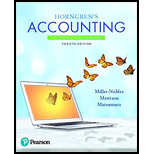
On January 1, 2018, a business borrowed $18,000 on a five-year, 5% note payable. At December 31, 2018, the business should record
Learning Objective 1
- interest payable of $900.
- note receivable of $18,000.
- cash payment of $18,000.
- nothing. (The note is already on the books.)
Note Payable: Note Payable is a written agreement under which the Borrower obtains a certain sum of money from the Lender for a specific period of time. It carries a specific rate of interest. The borrowed sum along with interest is to be returned to the Lender after the expiry of the specified time period
To determine:
What entry should be record at the yearend i.e. December 31, 2018
Answer to Problem 1QC
Solution:
a. Interest payable of $900
Explanation of Solution
• Given:
On January 1, 2018, a business borrowed $18000 on a 5 year, 5% note payable.
• Formula used:
Interest Amount = Borrowed Sum * Interest Rate* Time Period
• Calculation:
Interest Amount = $18000*5%*1year
■ = $900
• According to the accrual basis of accounting, interest on note payable should be accrued in the books of accounts irrespective of its payment. It means although payment of interest has not been done, but the same must be recorded in the books of accounts because the interest is accrued on note payable. While recording this transaction, an expense is booked and a liability is created simultaneously. Here, in this question, the business should record interest payable of $900 at the year end. This is because the business has used the borrowed amount for 1year and for this usage of money, interest becomes payable to the lender. Although the interest has not been paid, but the same must be recorded in the books since it has been accrued. The Journal entry in this case would be:
Interest Expense Dr $900
To Interest Payable $900
(Being interest on note payable accrued for 1 year)
From the above discussion, we can conclude that the business should record interest payable of $900 at December 31, 2018 following the accrual basis of accounting.
Want to see more full solutions like this?
Chapter 11 Solutions
Horngren's Accounting (12th Edition)
- Question 5: Acid-Test RatioA company has the following data: Cash: $50,000Accounts Receivable: $30,000Inventory: $60,000Current Liabilities: $70,000a) What is the company’s acid-test ratio?b) Is the company in a strong liquidity position based on this ratio?arrow_forwardQuestion 4: Depreciation (Straight-Line Method)A company purchases machinery for $50,000. The estimated salvage value is $5,000, and the useful life is 10 years. a) Calculate the annual depreciation expense.b) What will the book value of the machinery be after 4 years?arrow_forwardInventory Valuation (FIFO Method)A company had the following inventory transactions during the month: Beginning inventory: 100 units @ $10 eachPurchase: 200 units @ $12 eachPurchase: 150 units @ $13 eachAt the end of the month, 250 units remain in inventory. Calculate the value of the ending inventory using the FIFO method. explainarrow_forward
- Need assistance without use of ai.arrow_forwardDepreciation (Straight-Line Method)A company purchases machinery for $50,000. The estimated salvage value is $5,000, and the useful life is 10 years. a) Calculate the annual depreciation expense.b) What will the book value of the machinery be after 4 years?arrow_forwardA company has the following data: Cash: $50,000Accounts Receivable: $30,000Inventory: $60,000Current Liabilities: $70,000a) What is the company’s acid-test ratio?b) Is the company in a strong liquidity position based on this ratio?arrow_forward
- Don't want AI answerarrow_forwardXYZ Corporation produces a product that sells for $30 per unit. The variable cost per unit is $18. Fixed costs for the year are $72,000. a) What is the contribution margin per unit? b) What is the contribution margin ratio? c) What is the break-even sales in dollars?arrow_forwardI need solution with step by step....?!arrow_forward
- Question 1: Break-Even Analysis A company sells a product for $25 per unit. The variable cost per unit is $15, and the total fixed costs are $50,000. a) How many units must the company sell to break even? b) If the company wants a profit of $10,000, how many units must it sell?arrow_forwardNeed this question answer properly.arrow_forwardRight Answerarrow_forward

 AccountingAccountingISBN:9781337272094Author:WARREN, Carl S., Reeve, James M., Duchac, Jonathan E.Publisher:Cengage Learning,
AccountingAccountingISBN:9781337272094Author:WARREN, Carl S., Reeve, James M., Duchac, Jonathan E.Publisher:Cengage Learning, Accounting Information SystemsAccountingISBN:9781337619202Author:Hall, James A.Publisher:Cengage Learning,
Accounting Information SystemsAccountingISBN:9781337619202Author:Hall, James A.Publisher:Cengage Learning, Horngren's Cost Accounting: A Managerial Emphasis...AccountingISBN:9780134475585Author:Srikant M. Datar, Madhav V. RajanPublisher:PEARSON
Horngren's Cost Accounting: A Managerial Emphasis...AccountingISBN:9780134475585Author:Srikant M. Datar, Madhav V. RajanPublisher:PEARSON Intermediate AccountingAccountingISBN:9781259722660Author:J. David Spiceland, Mark W. Nelson, Wayne M ThomasPublisher:McGraw-Hill Education
Intermediate AccountingAccountingISBN:9781259722660Author:J. David Spiceland, Mark W. Nelson, Wayne M ThomasPublisher:McGraw-Hill Education Financial and Managerial AccountingAccountingISBN:9781259726705Author:John J Wild, Ken W. Shaw, Barbara Chiappetta Fundamental Accounting PrinciplesPublisher:McGraw-Hill Education
Financial and Managerial AccountingAccountingISBN:9781259726705Author:John J Wild, Ken W. Shaw, Barbara Chiappetta Fundamental Accounting PrinciplesPublisher:McGraw-Hill Education





